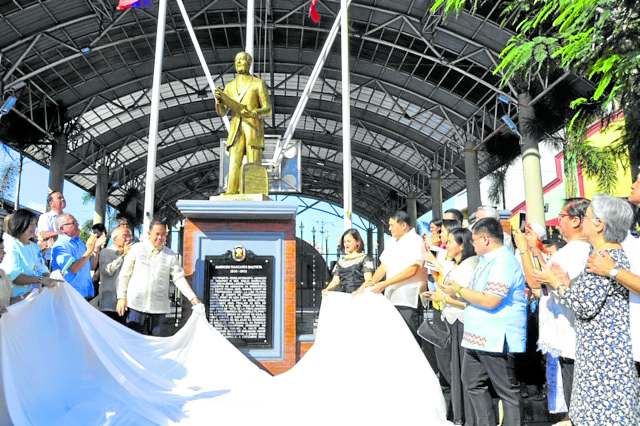Biñan honors little-known player in Independence Day rites

LAGUNA PRIDE Officials of Biñan City and guests, in a ceremony in 2018, unveil the statue of Ambrosio Rianzares Bautista, the local lawyer who wrote and read the Philippines’ Declaration of Independence and waved the flag during rites at Kawit, Cavite, in 1898. —CONTRIBUTED PHOTO
SAN PEDRO, Laguna, Philippines — Though less popular but with an equally remarkable role in history, Laguna native Ambrosio Rianzares Bautista not only wrote and publicly read the Declaration of Independence but he, too, waved the Philippine flag in that iconic scene at Gen. Emilio Aguinaldo’s house in Kawit, Cavite province, 122 years ago.
Acknowledging this fact brought a welcome surprise to Biñan City in Laguna province, especially as it has been promoting the life of the lawyer-propagandist in recent years.
Bautista, who was born in Biñan on Dec. 7, 1830, was a distant relative of national hero, Dr. Jose Rizal, who regarded him as his “Tio Bosyong,” according to accounts from the National Historical Commission of the Philippines (NHCP).
Bautista supported the Propaganda Movement for government reforms before serving as political adviser and war auditor of Aguinaldo up until the Philippines declared its independence from Spain in 1898.
Popular image
“Contrary to popular belief, on 12 June 1898 the Philippine flag was waved by (Bautista), not by (Aguinaldo). It was done at the window of Aguinaldo’s bahay na bato, not at the balcony which did not exist at the time,” the NHCP said in a publicity material in time for the Independence Day commemoration on Friday.
Article continues after this advertisementThe country may see another “history” unfold in time of a pandemic as it is likely to cancel a public Independence Day commemoration and replace it with a program streamed online.
Article continues after this advertisementIn a telephone interview on Wednesday, NHCP Chair Rene Escalante said not too many Filipinos knew about Bautista. But rather than discrediting anyone, the commission meant to “recognize” everyone who took part in the historical event, he said.
Wensley Reyes, a history professor at the Philippine Normal University, said the “popular image” depicting Aguinaldo as waving the flag in an old Philippine banknote might have “affected” people’s perception of Independence Day.
Course of history
“Our conception of history is often influenced by art depicting historical events. These images in history were propagated to the minds of the people … which affected how we, as a nation, visualized this event,” Reyes said.In Biñan, old government buildings, like the city council’s session hall, were named after Bautista.
In 2018, the city government unveiled a monument of Bautista with a refabricated marker to replace a 1980 one that went missing, said Bryan Jayson Borja, the city’s history, culture and arts officer.
“I’m quite surprised [that the NHCP recognized Ambrosio] as we were just thinking how to make Ambrosio known to the public as someone with a significant role in history,” Borja said.
“(Ambrosio) having waved the flag doesn’t change the course of history, but it says much about his role in the revolution,” he said.